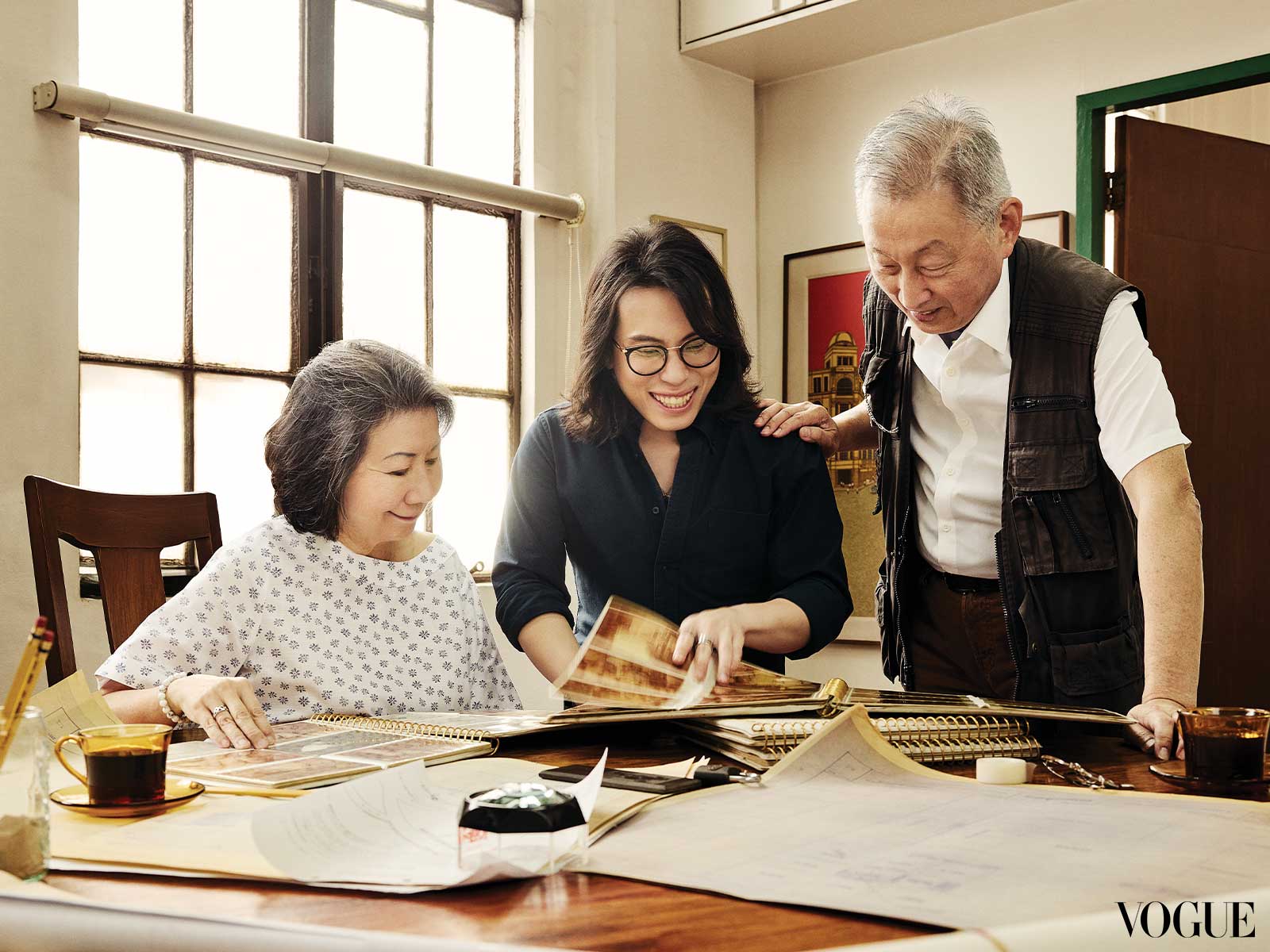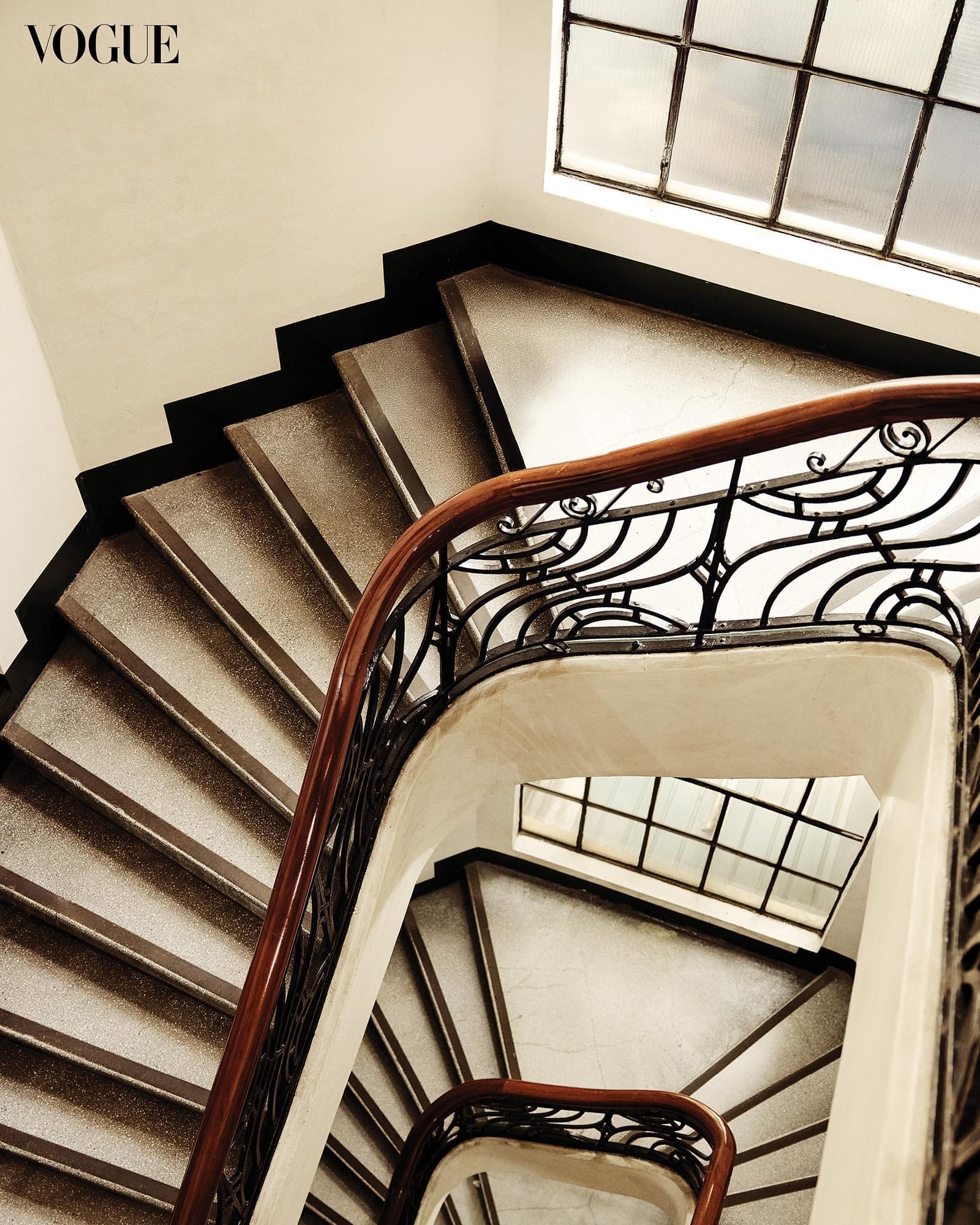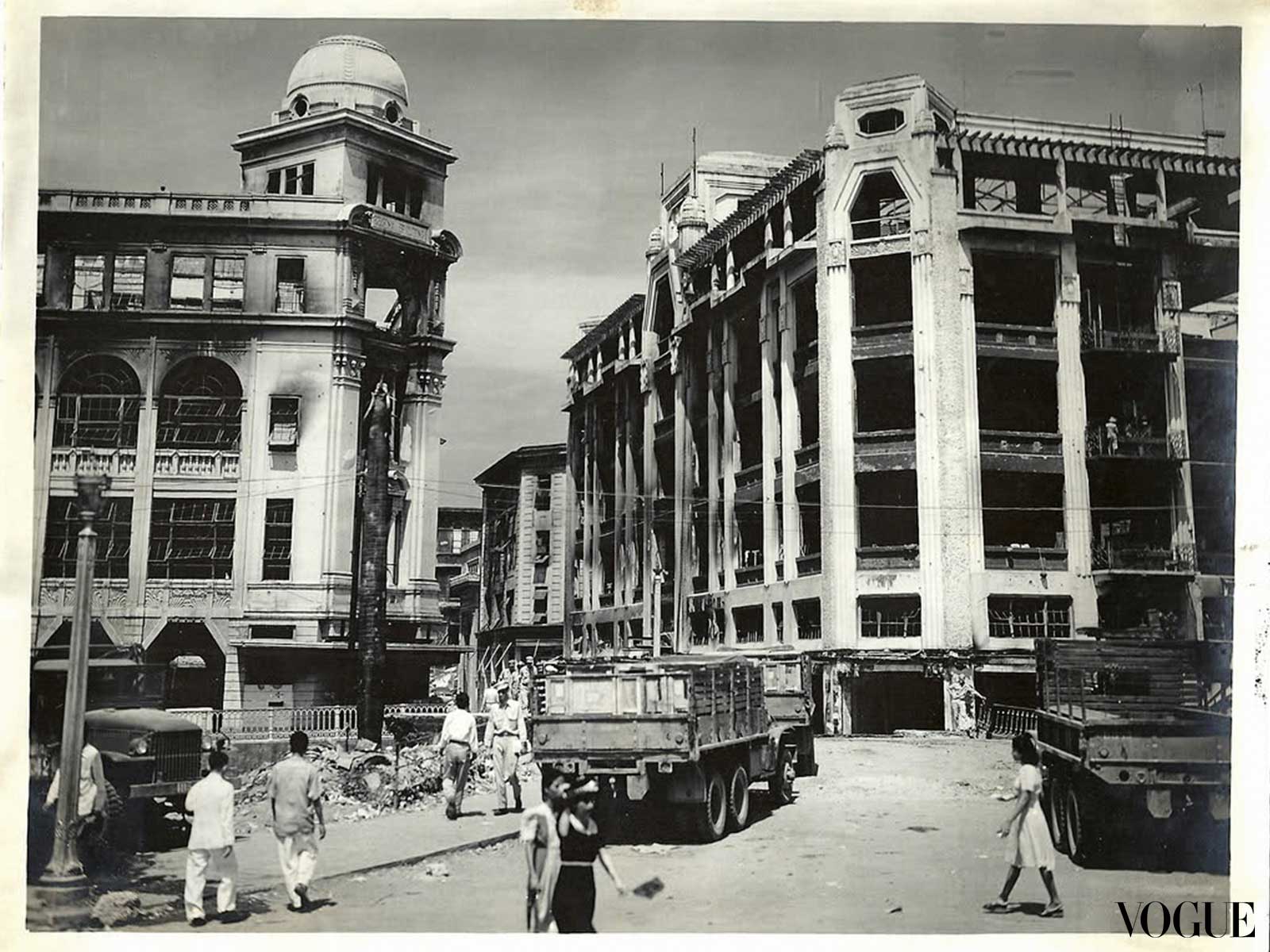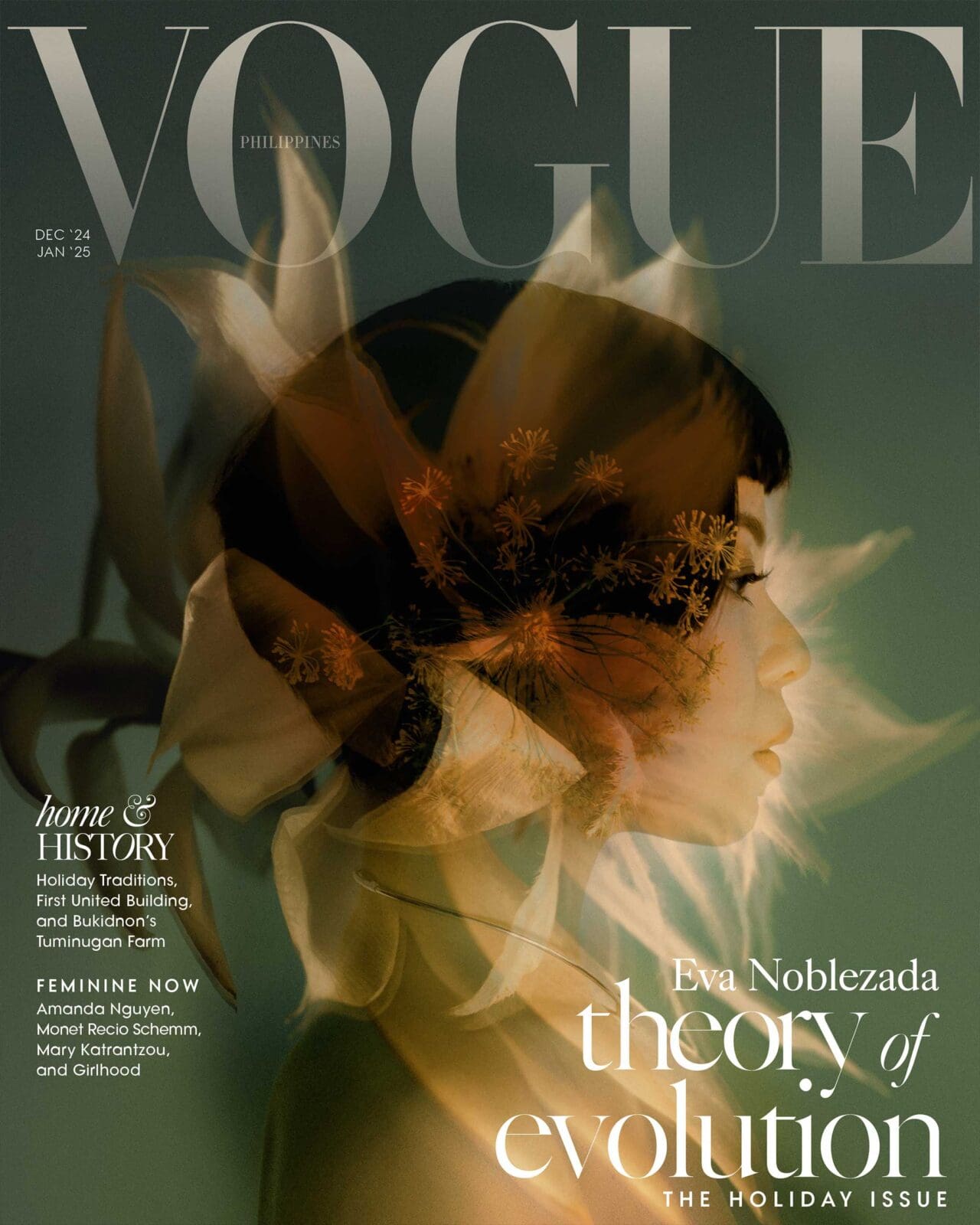Robby Sylianteng has taken over the reins as managing director of the First United Building, bringing with him fresh perspectives and a common language needed to connect with artists. Robby wears a ZIMMERLI tank top and UNIQLO shirt. Photographed by Gabriel Nivera for the December 2024/January 2025 Issue of Vogue Philippines
Through the landmark First United Building, a community of creatives care for Manila’s history and culture.
In Escolta’s pre-war heyday, the Perez-Samanillo building possessed one of the city’s most prestigious business and commercial addresses, with banks, law firms, and dental offices occupying its five floors. Nearly a hundred years since it was built, these same floors are now filled with artist-run spaces, design studios, and creative startups. Outside, a snarl of electrical wires crisscrosses the street, while jeepneys and pushcart vendors ply the lanes. The scene is noticeably grittier and more crowded than the ones found in the sepia-toned landscapes posted on the Facebook page Manila Nostalgia. But the building still stands, a proud relic of Manila’s gilded age. What could have been its inexorable slide into the hands of decay or demolition has been turned around by the collective efforts of the building’s stewards and entrepreneurial tenants. They have breathed new life, not just inside its walls, but out onto the streets of which Escolta was once hailed queen.
The structure now known as the First United Building was designed by Andres Luna de San Pedro, son of the painter Juan Luna and Paz Pardo de Tavera. After studying architecture in Paris, Andres returned to Manila and was appointed Chief Architect by the city governor. He later put up his own practice, training other architects like Juan Nakpil, who worked with him on designing the building commissioned by the Perez-Samanillo family. Completed in 1928, it was the most modern edifice of its time, with a glass façade and an Otis elevator. Though now described as Art Deco in style, at the time the architecture was in line with contemporary trends, heavily influenced by the 1925 International Exposition of Modern Industrial and Decorative Arts in Paris, which both Luna and Nakpil visited, as noted by heritage writer Isidra Reyes. In 1928, it won first prize in the House Beautiful Contest held by the City of Manila.
In 1939, Berg Department Store took over the former spot of Lyric Music House on the building’s ground floor on the corner of Escolta and Calle David. Berg’s, as it was called, was the Rustan’s of the time, where women went to buy special occasion outfits and shoes in the Ladies Ready Wear department.

The 1945 Battle of Manila devastated Escolta. The Crystal Arcade, Andres Luna’s glass masterpiece and Manila’s first modern shopping mall with air conditioning, was laid to ruin. The Perez-Samanillo and its sister building the Regina suffered damage but survived. In the aftermath, the Berg family returned to the United States, leaving the department store to Mr. Sy Lian Teng, businessman originally from China. The 1950s was a time of reconstruction. As Lou Goupal chronicles in his Manila Nostalgia blog, Mr. Sy Lian Teng maintained Berg’s as a family-run business, aided by his wife Emerenciana, son Robert and his wife Lorraine, until it was closed in 1981. The character of Escolta had by then changed, with most of the businesses in the area relocating to Makati and Greenhills. The Sy Lian Teng family (now Sylianteng), however, stayed put, and bought up a large chunk of the building.
FUB’s revival was first instigated by Robert and Lorraine, who decided it was time to shake up the makeup of their building, and in 2012 leased the mezzanine to 98B Collaboratory, a multidisciplinary art lab. The 98B folks held Saturday X Future markets and art exhibits on the ground floor, and when the architecture studio One/Zero Design moved in, they worked together to transform the former Berg’s space into the HUB: Make Lab, an incubator and retail space for makers and artists. More creatives and start-ups were called to the building, drawn by the cheap rent and emergent energy that was reminiscent of Cubao X, the former shoe emporium that made a comeback as an artist hub in the 2000s.
New faces were taking over old places, giving birth to new spaces that resist the homogenization of commercial planning. “We’ve always thought of old towns with sentimentality for the past; how can we make new memories from them?” Arts Serrano of One/Zero says. Architecture, he believes, should reflect the culture, history, and people it serves. “We want everyone to realize we all have a chance to have a hand at defining our cities.”

The Escolta Block Parties that first sprung up in 2016 captured this sense of placemaking. Beyond the FUB community, the street fest has involved owners of other buildings and members of the larger community like vendors and security guards. The street was packed with thousands, with music, markets, and open studios reactivating the once blighted area block by block, street by street. After the pandemic, the event was reconceptualized as Hola Escolta, moving away from the hedonism associated with parties.
Today, Robert and Lorraine’s youngest son Robby has taken over the reins as managing director of the FUB after living in the United States for over a decade, bringing with him fresh perspectives and importantly, a common language needed to connect with the artists, something his parents found challenging at times. With an educational background in architecture and urban design, Robby has become instrumental in guiding their renovation decisions, working closely with his father and the engineers to make sure that modern improvements honor the aesthetics of the building.
When Gio Abcede of the Heritage Conservation Society approached the family about entering the 2024 Good Design Award Philippines, it was Robby who took the lead. His parents are more reserved when it comes to publicity and prefer to manage their growth organically, but Robby saw the value of exposure. “It gives more people an opportunity to discover their heritage. Filipino or Chinese Filipino entrepreneurship was built upon the backbones of that street. I think it’s right that people know where today’s businesses come from,” he says. “And maybe it’s also a reminder of practices we shouldn’t do, like leaving our cities to move on to the next better thing.”

In June, the FUB took home the Malasakit Gran Prix award. “The historic building’s transformation shows the power of placemaking, where it’s not just the walls and posts that make a place but the communities that flourish in it. The restored First United Building in Escolta revitalized the district, attracting creative tenants and drawing a new demographic of visitors and regular audiences that come to Escolta to escape the cookie-cutter spaces that proliferate in many urban areas,” said jury chair Mylene Abiva. “Despite challenges, the building’s revival showcases the power of design and preservation, not only in restoring its past but also in fostering Escolta’s economic resurgence that caters to the next generation of the creative class.”
It was around 2011 when the architect Dominic Galicia approached the Syliantengs about restoring the FUB. Heritage was increasingly entering the conversation since many of the old buildings were being demolished to make way for high-rise condominiums. Galicia recommended that they reveal the original ceilings, which were lowered in the 1990s and 2000s by tenants who wanted to save on air conditioning costs. “It’s an architectural footprint for Filipinos. If you keep these drop ceilings, nobody will get to see these sconces and the details of how people used to build in the 1920s,” explains Robby. “You kind of lose an architectural language.”
Hints of the building’s original splendor are visible in spaces like Espacio Creativo, Belg Belgica’s photography studio with its 15-foot ceilings and abundant natural light, a nod to the first photography studios located on Escolta. At the First Coworking Community designed by One/Zero, the walls have been stripped to bare concrete, cracks and all, framing a grand view of the dome of the Regina Building across the street. The sixth-floor Dome, opened to the public just last year, hosted its first event: an intimate candlelight performance by the Manila Philharmonic. The haunting, cavernous space of the Dome is Art Deco without the decoration, just a raw surface whose cracks have been patched over in a random network of squiggles. Lorraine posed the question on social: Paint or no paint? The overwhelming majority voted to leave it unfinished, perfect already as it was.

The FUB has been hailed as a model example of adaptive reuse, but Robby feels that the term doesn’t fully encompass their approach to urban renewal. “We need to rename adaptive reuse, because nowadays it’s not enough to adapt when you’re a heritage building; it needs to be transformative. Its reuse that creates experiences for people, reuse that allows people to think differently about what a place can be,” he says.
Within its walls, a sustainable ecosystem is taking shape, or as Robby puts it, a “beast that feeds itself in the long run.” Project Lemons is an example of this organic growth: what began as a modest venture selling cat stickers and Pinoy pop culture mugs at the HUB has grown so rapidly that they now occupy office and storage spaces on the upper floors. They put back into the creative community by offering practical workshops like “BIR Basics for Creatives” and “Accounting 101 for Artists.”
Jodinand Aguillon is another tenant whose presence has had a multiplier effect on the building. Moving Glorious Dias, his vintage clothing label, to the HUB in 2021 has been a homecoming of sorts, the FUB a perfect backdrop to his reworked barongs and splashy retro prints. “It’s because of Jodi that we are maximum occupancy,” Robby says. “The challenge for us will always be finding that sweet spot where modernization can co-exist in harmony with what is left to be preserved,” Jodinand says. “While Escolta is home to so many firsts, it’s also been a hub for even more second chances.”
Since the Good Design Award, Robby’s been approached by landlords and building owners in Cebu and Davao who have been asking him how to do it. Robby is hoping to create a model for transformative reuse that can be adapted to different locations. Transformative, “because that’s what allows people to hope, that’s what allows people to imagine,” he says. Transformative, because “that’s what allows people to discern between possibility and potentiality.”
By AUDREY CARPIO Photographs by GABRIEL NIVERA. Associate Fashion Editor: Carlos Mangubat. Grooming: Don de Jesus. Producer: Bianca Zaragoza. Features Writer: Patricia Villoria. Photographer’s Assistant: Jumigo Rafols.

